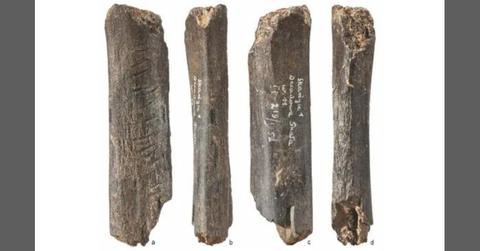Prehistoric Creativity: Study Suggests 130,000-Year-Old Bear Bone Carved by Neanderthals Symbolic Art

Different views of a roughly 4-inches-long (10.6 centimeters) bear bone that has Neanderthal-made cut marks on it.
A bear bone nearly 130,000 years old, marked with deliberate cuts, might represent one of the oldest pieces of art in Eurasia created by Neanderthals, researchers suggest.
This cylindrical bone, about 4 inches long, features 17 irregularly spaced parallel cuts, likely crafted by a right-handed individual in a single session, according to a recent study.
This carved bone, found north of the Carpathian Mountains, is the oldest known symbolic art by Neanderthals in Europe. It offers insights into the behavior, cognition and culture of these early humans, who lived in Eurasia from about 400,000 to 40,000 years ago before their extinction.
"It is one of the quite rare Neanderthal objects of symbolic nature," stated Tomasz Płonka, professor of archaeology at the University of Wrocław, to Live Science. "These incisions have no utilitarian reason." The study concluded that the bone was neither a tool nor an object of ritual significance.
Discovered in 1953 in Dziadowa Skała Cave in southern Poland, the bone was initially thought to be a bear rib. Excavated from a layer dating to the Eemian period (130,000 to 115,000 years ago), a warmer phase of the last ice age, Płonka's team later identified it as the radius from the left forelimb of a juvenile bear, probably a brown bear.
In their new study, researchers used a 3D microscope and computed tomography (CT) scans to create a digital model of the bone. This analysis revealed that the marks showed intentional organization: they were repetitive, similar in shape, confined to a specific area and systematically placed despite slight variations in spacing.
- What Lies Beneath: NASA Scientist Believes Aliens May Have Found 'Perfect' Hiding Spot in Earth's Oceans
- Global Threat: Russia Insider Warns West of 'World War Using Nuclear Weapons' Amid Escalating Support for Ukraine
- Countdown to Disaster? Ex-NATO Official Warns Russia, Iran and China Could Wage WWIII in Just Years
These patterns suggest that the prehistoric artist was not merely doodling but exhibited advanced cognitive abilities.
The study, published in the Journal of Archaeological Science, explored how the incisions were made by replicating marks on fresh cattle bones with flint blades and Middle Paleolithic knives using seven incision techniques, including to-and-fro movements and vigorous sawing.
Never miss a story — sign up for the Front Page Detectives newsletter. Be on the scene the moment news breaks.
The researchers found the marks were inconsistent with butchering, tool use or animal trampling, indicating they were likely made intentionally in one sitting with a flint knife. Most incisions were quick, repeated knife movements toward the operator, suggesting a right-handed creator.
"Most of the incisions have a very characteristic comma-like end that curves to the right. When our experimenter, a right-handed person, moved the flint instrument towards himself, the incisions curved to the right," Płonka explained. "Therefore, we know that the Neanderthal who made these incisions was right-handed."
Płonka speculated that the maker might have been trying to convey a numerical message.
Become a Front Page Detective
Sign up to receive breaking
Front Page Detectives
news and exclusive investigations.
